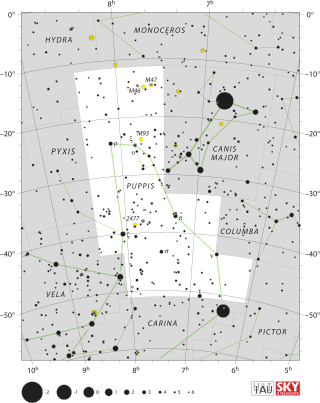Sigma Puppis
Star in the constellation Puppis From Wikipedia, the free encyclopedia
Sigma Puppis, Latinized from σ Puppis, is a binary star system in the southern constellation Puppis. It has an apparent visual magnitude of 3.25,[2] which is bright enough to be visible to the naked eye at night from the Southern Hemisphere. Through a telescope, it appears as a bright, orange-hued star with a nearby white companion.[10] Parallax measurements indicate this star is located at a distance of about 192 light-years (59 parsecs) from Earth.[1]

| Observation data Epoch J2000 Equinox J2000 | |
|---|---|
| Constellation | Puppis |
| Right ascension | 07h 29m 13.83263s[1] |
| Declination | −43° 18′ 05.1674″[1] |
| Apparent magnitude (V) | 3.25[2] |
| Characteristics | |
| Spectral type | K5 III[3] |
| U−B color index | +1.77[2] |
| B−V color index | +1.52[2] |
| Astrometry | |
| Radial velocity (Rv) | +87.3[4] km/s |
| Proper motion (μ) | RA: +199.39 mas/yr[1] Dec.: −61.828 mas/yr[1] |
| Parallax (π) | 17.0234±0.5614 mas[1] |
| Distance | 192 ± 6 ly (59 ± 2 pc) |
| Absolute magnitude (MV) | −0.50[5] |
| Orbit[6] | |
| Period (P) | 257.8 days |
| Eccentricity (e) | 0.17 |
| Periastron epoch (T) | 20418.6 |
| Argument of periastron (ω) (secondary) | 349.3° |
| Semi-amplitude (K1) (primary) | 18.6 km/s |
| Details | |
| σ Pup A | |
| Mass | 1.65[7] M☉ |
| Radius | 43.7[4] R☉ |
| Luminosity | 344[7] L☉ |
| Surface gravity (log g) | 1.51[7] cgs |
| Temperature | 4,077±4[7] K |
| Rotational velocity (v sin i) | 3.0[8] km/s |
| Other designations | |
| σ Pup, Sigma Pup, CPD−43 1499, FK5 1194, GC 10040, HD 59717, HIP 36377, HR 2878, SAO 218755, WDS J07292-4318A[9] | |
| Database references | |
| SIMBAD | data |
This is a spectroscopic binary system,[9] consisting of an orbiting pair of stars that have not been individually resolved with a telescope. Their orbital period is 257.8 days and the eccentricity is 0.17.[6] The pair form an eclipsing binary of the Beta Lyrae type and a period of 130.5 days, or one half of their orbital period. The eclipse of the primary component causes a decline of 0.04 of a magnitude, while the secondary eclipse reduces the magnitude by 0.03.[11][12]
The combined stellar classification is K5 III,[3] which matches the spectrum of a giant star. The primary is 44 times larger than the Sun[4] and 340 times more luminous. Its surface has an effective temperature of 4,077 K,[7] giving it the orange hue of a K-type star.[13] It shows the behavior of a slow irregular variable.[11][12]
In addition to its binary components, Sigma Puppis has a more distant companion that has a matching proper motion, suggesting that it may be gravitationally bound to the binary. This magnitude 8.5[10] star is at an angular separation of 22.4 arcseconds with a position angle of 74° from Sigma Puppis, which is equivalent to a projected separation of 1,200 AU.[14] In 1970, American astronomer Olin J. Eggen suggested that Sigma Puppis belonged to a moving group of stars that share a similar motion through space, and thereby a common origin. It served as the eponym for this, the σ Puppis group.[15] The existence of this group was later brought into question.[16]
References
Wikiwand - on
Seamless Wikipedia browsing. On steroids.

